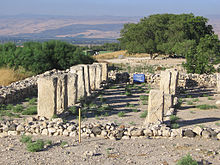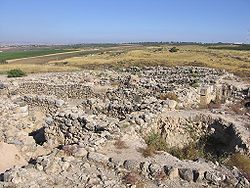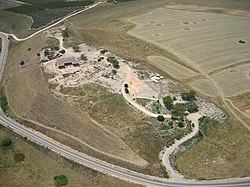Tel Hazor: Perbedaan antara revisi
kTidak ada ringkasan suntingan |
k Robot: Perubahan kosmetika |
||
| Baris 4: | Baris 4: | ||
{{Infobox World Heritage Site |
{{Infobox World Heritage Site |
||
| WHS = Biblical Tells – [[Megiddo (place)|Megiddo]], Hazor, [[Tel Be'er Sheva|Beer Sheba]] |
| WHS = Biblical Tells – [[Megiddo (place)|Megiddo]], Hazor, [[Tel Be'er Sheva|Beer Sheba]] |
||
| Image = [[ |
| Image = [[Berkas:Hatzor-HouseofPillars.jpg|thumb]] |
||
| State Party = [[Israel]] |
| State Party = [[Israel]] |
||
| Type = Cultural |
| Type = Cultural |
||
| Baris 21: | Baris 21: | ||
== Hazor Kanaan == |
== Hazor Kanaan == |
||
[[ |
[[Berkas:Hatzor-IsraeliteBastion.jpg|thumb|250px|Peninggalan bersejarah di Hazor]] |
||
Selama [[Periode Pertengahan Kedua]] Mesir dan awal [[Kerajaan Baru]] (keduanya dari abad ke-18 sampai ke-15 SM), [[Kanaan]] adalah negara taklukan Mesir; sehingga dokumen abad ke-14 SM, dari ruang arsip [[El Amarna]] di [[Mesir kuno|Mesir]], mencatat raja Hazor (dalam [[Surat Amarna]] disebut ''Hasura''), ''Abdi-Tirshi'', bersumpah setia kepada Firaun Mesir. Namun, EA 148 secara khusus melaporkan bahwa raja Hasura telah beralih setia kepada orang [[Habiru]] yang menyerang Kanaan. Dalam dokukmen-dokumen ini, Hazor digambarkan sebagai kota penting di Kanaan. Hazor juga disebut dalam teks Eksekrasi (''Execration texts''), yang lebih tua dari surat-surat Amarna, dan juga dalam dokumen-dokumen dari abad ke-18 SM yang ditemukan di kota Mari, Suriah, di tepi sungai [[Efrat]]. |
Selama [[Periode Pertengahan Kedua]] Mesir dan awal [[Kerajaan Baru]] (keduanya dari abad ke-18 sampai ke-15 SM), [[Kanaan]] adalah negara taklukan Mesir; sehingga dokumen abad ke-14 SM, dari ruang arsip [[El Amarna]] di [[Mesir kuno|Mesir]], mencatat raja Hazor (dalam [[Surat Amarna]] disebut ''Hasura''), ''Abdi-Tirshi'', bersumpah setia kepada Firaun Mesir. Namun, EA 148 secara khusus melaporkan bahwa raja Hasura telah beralih setia kepada orang [[Habiru]] yang menyerang Kanaan. Dalam dokukmen-dokumen ini, Hazor digambarkan sebagai kota penting di Kanaan. Hazor juga disebut dalam teks Eksekrasi (''Execration texts''), yang lebih tua dari surat-surat Amarna, dan juga dalam dokumen-dokumen dari abad ke-18 SM yang ditemukan di kota Mari, Suriah, di tepi sungai [[Efrat]]. |
||
<!-- |
<!-- |
||
According to the [[Book of Joshua]] Hazor was the seat of [[Jabin]], a powerful Canaanite king that led a Canaanite confederation against [[Joshua]], but was defeated by Joshua, who burnt Hazor to the ground.<ref>Joshua 11:1-5, 11:10-13</ref>{{primary source|date=December 2012}} According to the [[Book of Judges]] Hazor was the seat of Jabin, the king of Canaan, whose commander, [[Sisera]], led a Canaanite army against [[Barak]], but was ultimately defeated.<ref>Judges 4</ref> [[Textual criticism|Textual scholars]] believe that the prose account of Barak, which differs from the [[poem|poetic]] account in the [[Song of Deborah]], is a conflation of accounts of two separate events, one concerning Barak and Sisera like the poetic account, the other concerning Jabin's confederation and defeat.<ref name=Peakes>''[[Peake's commentary on the Bible]]''</ref> In addition, the Book of Judges and Book of Joshua may be parallel accounts referring to the same events, rather than describing different time periods,<ref name=Peakes/><ref>''Jewish Encyclopedia'', ''Book of Joshua'', ''Book of Judges''</ref> and thus that they refer to the same Jabin, a powerful king based in Hazor, whose Canaanite confederation was defeated by an [[Israelite]] army.<ref>''Jewish Encyclopedia'', ''Jabin''</ref> |
According to the [[Book of Joshua]] Hazor was the seat of [[Jabin]], a powerful Canaanite king that led a Canaanite confederation against [[Joshua]], but was defeated by Joshua, who burnt Hazor to the ground.<ref>Joshua 11:1-5, 11:10-13</ref>{{primary source|date=December 2012}} According to the [[Book of Judges]] Hazor was the seat of Jabin, the king of Canaan, whose commander, [[Sisera]], led a Canaanite army against [[Barak]], but was ultimately defeated.<ref>Judges 4</ref> [[Textual criticism|Textual scholars]] believe that the prose account of Barak, which differs from the [[poem|poetic]] account in the [[Song of Deborah]], is a conflation of accounts of two separate events, one concerning Barak and Sisera like the poetic account, the other concerning Jabin's confederation and defeat.<ref name=Peakes>''[[Peake's commentary on the Bible]]''</ref> In addition, the Book of Judges and Book of Joshua may be parallel accounts referring to the same events, rather than describing different time periods,<ref name=Peakes/><ref>''Jewish Encyclopedia'', ''Book of Joshua'', ''Book of Judges''</ref> and thus that they refer to the same Jabin, a powerful king based in Hazor, whose Canaanite confederation was defeated by an [[Israelite]] army.<ref>''Jewish Encyclopedia'', ''Jabin''</ref> |
||
--> |
--> |
||
[[ |
[[Berkas:Tel hatzor.JPG|thumb|right|250px|Foto udara Tel Hazor]] |
||
[[ |
[[Berkas:Hatzor-SolomonicGate.jpg|thumb|right|250px|Pintu gerbang berkamar dari zaman raja Salomo.]] |
||
<!-- |
<!-- |
||
[[Israel Finkelstein]] claims that the Israelites emerged as a subculture within Canaanite society, and the Israelite conquest of Canaan did not happen as detailed in the Bible.<ref name=Finkelstein>[[Israel Finkelstein]], ''[[The Bible Unearthed]]''</ref> In this view, the Book of Joshua conflates several independent battles between disparate groups, over multiple centuries, and artificially attributes them to a single leader - Joshua.<ref name=Peakes/> Nevertheless, one archaeological [[stratum]], dating from around 1200 BC, shows signs of catastrophic fire, and cuneiform tablets found at the site refer to monarchs named ''Ibni Addi'', where ''Ibni'' may be the [[etymology|etymological]] origin of ''Yavin'' (''Jabin'').[http://www.mfa.gov.il/MFA/History/Early%20History%20-%20Archaeology/Hatzor%20-%20The%20Head%20of%20all%20those%20Kingdoms]<ref name=Finkelstein/> The city also show signs of having been a magnificent Canaanite city prior to its destruction, with great temples and opulent palaces,<ref name=Finkelstein/> split into an upper [[acropolis]], and lower city; the town evidently had been a major Canaanite city. He theorizes that the destruction of Hazor was the result of civil strife, attacks by the [[Sea Peoples]], and/or a result of the general collapse of civilization across the whole eastern Mediterranean in the Late Bronze Age.<ref name=Finkelstein/> |
[[Israel Finkelstein]] claims that the Israelites emerged as a subculture within Canaanite society, and the Israelite conquest of Canaan did not happen as detailed in the Bible.<ref name=Finkelstein>[[Israel Finkelstein]], ''[[The Bible Unearthed]]''</ref> In this view, the Book of Joshua conflates several independent battles between disparate groups, over multiple centuries, and artificially attributes them to a single leader - Joshua.<ref name=Peakes/> Nevertheless, one archaeological [[stratum]], dating from around 1200 BC, shows signs of catastrophic fire, and cuneiform tablets found at the site refer to monarchs named ''Ibni Addi'', where ''Ibni'' may be the [[etymology|etymological]] origin of ''Yavin'' (''Jabin'').[http://www.mfa.gov.il/MFA/History/Early%20History%20-%20Archaeology/Hatzor%20-%20The%20Head%20of%20all%20those%20Kingdoms]<ref name=Finkelstein/> The city also show signs of having been a magnificent Canaanite city prior to its destruction, with great temples and opulent palaces,<ref name=Finkelstein/> split into an upper [[acropolis]], and lower city; the town evidently had been a major Canaanite city. He theorizes that the destruction of Hazor was the result of civil strife, attacks by the [[Sea Peoples]], and/or a result of the general collapse of civilization across the whole eastern Mediterranean in the Late Bronze Age.<ref name=Finkelstein/> |
||
| Baris 75: | Baris 75: | ||
== Pranala luar == |
== Pranala luar == |
||
{{Commons|Hatzor}} |
{{Commons|Hatzor}} |
||
* [http://hazor.huji.ac.il The Hazor Excavations Project] |
* [http://hazor.huji.ac.il The Hazor Excavations Project] - [[Hebrew University of Jerusalem]] |
||
*[http://www.yadinproductions.com/yadin_archeology.html "Yadin photographs & footage of the excavations"] |
* [http://www.yadinproductions.com/yadin_archeology.html "Yadin photographs & footage of the excavations"] |
||
* [http://hazor.huji.ac.il/hazorbooks.htm The Hazor Excavation Reports] |
* [http://hazor.huji.ac.il/hazorbooks.htm The Hazor Excavation Reports] - Hebrew University of Jerusalem |
||
* [http://whc.unesco.org/en/list/1108 UNESCO World Heritage site for Hazor] |
* [http://whc.unesco.org/en/list/1108 UNESCO World Heritage site for Hazor] |
||
*[http://www.fas.harvard.edu/~semitic/wl/digsites/NLevant/Tel-Hazor_09/index.htm Shelby White - Leon Levy grant to publish current digs] |
* [http://www.fas.harvard.edu/~semitic/wl/digsites/NLevant/Tel-Hazor_09/index.htm Shelby White - Leon Levy grant to publish current digs] |
||
* [http://www.biblicalarcheology.net/the-city-of-hazor-and-old-testament-accuracy/ Penggalian di Hazor membuktikan keakuratan Alkitab] |
* [http://www.biblicalarcheology.net/the-city-of-hazor-and-old-testament-accuracy/ Penggalian di Hazor membuktikan keakuratan Alkitab] |
||
| Baris 86: | Baris 86: | ||
{{DEFAULTSORT:Hazor}} |
{{DEFAULTSORT:Hazor}} |
||
[[ |
[[Kategori:Archaeological sites in Israel]] |
||
[[ |
[[Kategori:World Heritage Sites in Israel]] |
||
[[ |
[[Kategori:National parks of Israel]] |
||
[[ |
[[Kategori:Amarna letters locations]] |
||
[[ |
[[Kategori:Canaanite cities]] |
||
[[ |
[[Kategori:Former populated places in Southwest Asia]] |
||
Revisi per 2 September 2016 11.38
33°01′06″N 35°34′09″E / 33.018236°N 35.569053°E
| Situs Warisan Dunia UNESCO | |
|---|---|
 | |
| Kriteria | Cultural: ii, iii, iv, vi |
| Nomor identifikasi | 1108 |
| Pengukuhan | 2005 (29th) |
Tel Hazor (bahasa Ibrani: תל חצור), juga Hatzor, sekarang: Tell el-Qedah, adalah sebuah tell di atas lokasi kota kuno Hazor. Hazor adalah sebuah kota kuno di daerah Galilea Atas, sebelah utara Danau Galilea, antara kota kuno Rama dan Kadesh, di dataran tinggi yang memandang Danau Merom, di lembah Hula.
Ekspedisi ke Hazor pada pertengahan tahun 1950 yang dipimpin oleh Yigal Yadin merupakan ekskavasi arkeologis terpenting yang dilakukan oleh negara Israel pada permulaan pendirian negara tersebut. Merupakan tempat arkeologi terluas di sebelah utara Israel, dengan tell atas seluas 30 acre dan kota bawah lebih dari 175 acre.[1]
Pada tahun 2005, peninggalan sejarah di Hazor dijadikan Situs Warisan Dunia UNESCO sebagai bagian dari "Tempat bersejarah Alkitab - Megido, Hazor, Beer sheba" (Biblical Tels - Megiddo, Hazor, Beer Sheba).
Hazor Kanaan

Selama Periode Pertengahan Kedua Mesir dan awal Kerajaan Baru (keduanya dari abad ke-18 sampai ke-15 SM), Kanaan adalah negara taklukan Mesir; sehingga dokumen abad ke-14 SM, dari ruang arsip El Amarna di Mesir, mencatat raja Hazor (dalam Surat Amarna disebut Hasura), Abdi-Tirshi, bersumpah setia kepada Firaun Mesir. Namun, EA 148 secara khusus melaporkan bahwa raja Hasura telah beralih setia kepada orang Habiru yang menyerang Kanaan. Dalam dokukmen-dokumen ini, Hazor digambarkan sebagai kota penting di Kanaan. Hazor juga disebut dalam teks Eksekrasi (Execration texts), yang lebih tua dari surat-surat Amarna, dan juga dalam dokumen-dokumen dari abad ke-18 SM yang ditemukan di kota Mari, Suriah, di tepi sungai Efrat.


Hazor Israel
Peninggalan arkeologi menunjukkan bahwa beberapa saat setelah dihancurkan, kota Hazor dibangun kembali sebagai desa kecil.
Penggalian arkeologi
Lokasi Hazor sekitar 200 ekar (0,81 km2) luasnya, dengan kota atas menempati 1/8 area. Gundukan mencapai ketinggian 40 meter. Analisa awal dilakukan oleh John Garstang pada tahun 1926.[2]
Lihat pula
Referensi
- ^ Scorched wheat may provide answers on the destruction of Canaanite Tel Hazor
- ^ John Garstang, History in the Bible, American Journal of Economics and Sociology, vol. 3, no. 3, Essays in Memory of Franz Oppenheimer 1864-1943, pp. 371-385, 1944
Pustaka tambahan
- Yadin Yigael and Et Al. Yadin, Hazor I : An Account of the First Season of Excavations, 1955, Magnes Press, 1958
- Yadin Yigael, Hazor II: An Account of the Second Season of Excavations, 1956 [James A. De Rothschild Expedition at Hazor], Oxford University Press, 1961, ISBN 0-19-647165-6
- Yadin Yigael, Hazor III - IV. An Account of the Third and Fourth Seasons of Excavations, 1957-1958. The James A. De Rothschild Expedition at Hazor, Biblical Archaeology Society, 1989, ISBN 965-221-008-0
- A. Ben Tor and Robert Bonfil, Hazor: v. 5: The James A De Rothschild Expedition at Hazor (Ancient synagogues studies), Israel Exploration Society, 1997, ISBN 965-221-003-X
- Yadin Yigael, Hazor (Schweich Lectures on Biblical Archaeology), British Academy, 1972, ISBN 0-19-725925-1
- Yadin Yigael, Hazor: Rediscovery of a Great Citadel of the Bible, Littlehampton, 1975, ISBN 0-297-76845-X
- Schulamit Geva, Hazor, Israel (British Archaeological Reports (BAR)), BAR, 1989, ISBN 0-86054-689-6
- S. Zuckerman, Where is the Archive of Hazor Buried?, Biblical Archaeology Review, vol. 32, pp. 28–37, 2006
- S. Zuckerman, "'...Slaying oxen and Killing Sheep, Eating Flesh and Drinking Wine...': Feasting in Late Bronze Age Hazor," Palestine Exploration Quarterly, 139,3 (2007), 186-204.
Pranala luar
- The Hazor Excavations Project - Hebrew University of Jerusalem
- "Yadin photographs & footage of the excavations"
- The Hazor Excavation Reports - Hebrew University of Jerusalem
- UNESCO World Heritage site for Hazor
- Shelby White - Leon Levy grant to publish current digs
- Penggalian di Hazor membuktikan keakuratan Alkitab
Templat:World Heritage Sites in Israel Templat:National parks of Israel
